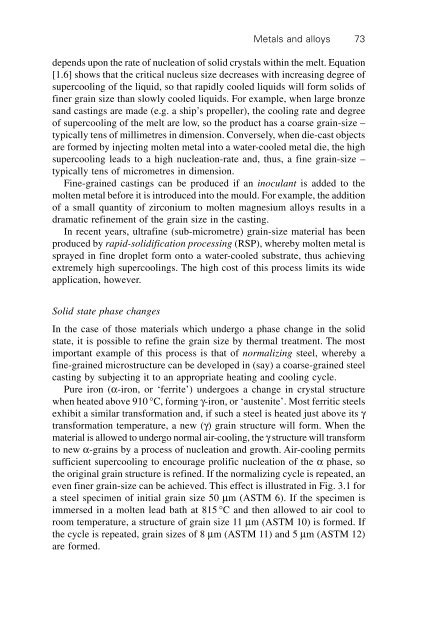Materials for engineering, 3rd Edition - (Malestrom)
Create successful ePaper yourself
Turn your PDF publications into a flip-book with our unique Google optimized e-Paper software.
Metals and alloys 73<br />
depends upon the rate of nucleation of solid crystals within the melt. Equation<br />
[1.6] shows that the critical nucleus size decreases with increasing degree of<br />
supercooling of the liquid, so that rapidly cooled liquids will <strong>for</strong>m solids of<br />
finer grain size than slowly cooled liquids. For example, when large bronze<br />
sand castings are made (e.g. a ship’s propeller), the cooling rate and degree<br />
of supercooling of the melt are low, so the product has a coarse grain-size –<br />
typically tens of millimetres in dimension. Conversely, when die-cast objects<br />
are <strong>for</strong>med by injecting molten metal into a water-cooled metal die, the high<br />
supercooling leads to a high nucleation-rate and, thus, a fine grain-size –<br />
typically tens of micrometres in dimension.<br />
Fine-grained castings can be produced if an inoculant is added to the<br />
molten metal be<strong>for</strong>e it is introduced into the mould. For example, the addition<br />
of a small quantity of zirconium to molten magnesium alloys results in a<br />
dramatic refinement of the grain size in the casting.<br />
In recent years, ultrafine (sub-micrometre) grain-size material has been<br />
produced by rapid-solidification processing (RSP), whereby molten metal is<br />
sprayed in fine droplet <strong>for</strong>m onto a water-cooled substrate, thus achieving<br />
extremely high supercoolings. The high cost of this process limits its wide<br />
application, however.<br />
Solid state phase changes<br />
In the case of those materials which undergo a phase change in the solid<br />
state, it is possible to refine the grain size by thermal treatment. The most<br />
important example of this process is that of normalizing steel, whereby a<br />
fine-grained microstructure can be developed in (say) a coarse-grained steel<br />
casting by subjecting it to an appropriate heating and cooling cycle.<br />
Pure iron (α-iron, or ‘ferrite’) undergoes a change in crystal structure<br />
when heated above 910 °C, <strong>for</strong>ming γ-iron, or ‘austenite’. Most ferritic steels<br />
exhibit a similar trans<strong>for</strong>mation and, if such a steel is heated just above its γ<br />
trans<strong>for</strong>mation temperature, a new (γ) grain structure will <strong>for</strong>m. When the<br />
material is allowed to undergo normal air-cooling, the γ structure will trans<strong>for</strong>m<br />
to new α-grains by a process of nucleation and growth. Air-cooling permits<br />
sufficient supercooling to encourage prolific nucleation of the α phase, so<br />
the original grain structure is refined. If the normalizing cycle is repeated, an<br />
even finer grain-size can be achieved. This effect is illustrated in Fig. 3.1 <strong>for</strong><br />
a steel specimen of initial grain size 50 µm (ASTM 6). If the specimen is<br />
immersed in a molten lead bath at 815 °C and then allowed to air cool to<br />
room temperature, a structure of grain size 11 µm (ASTM 10) is <strong>for</strong>med. If<br />
the cycle is repeated, grain sizes of 8 µm (ASTM 11) and 5 µm (ASTM 12)<br />
are <strong>for</strong>med.



